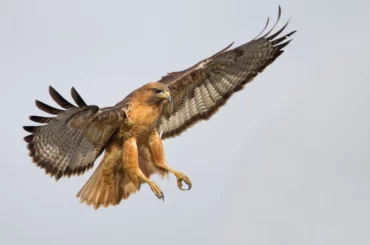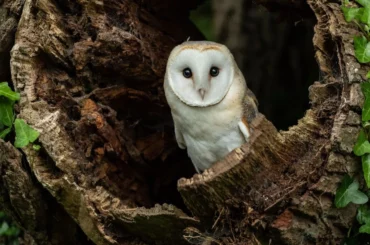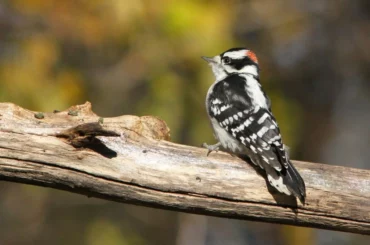Texas is one state with a lot of hummingbird activity. Only a few species call the state homeland year-round, and most occurrences occur between March and May, when hummingbirds are laying their eggs, and August to September, when they are migrating back to their winter habitats.
These little jeweled birds always dazzle with a splash of speed and amazing hovering abilities. Since many of these rare hummingbirds favor mountainous areas, the best places to see them in Texas are Big Bend National Park or the Davis Mountains.
Here is a list of hummingbird types in Texas.
1. Buff-Bellied Hummingbird
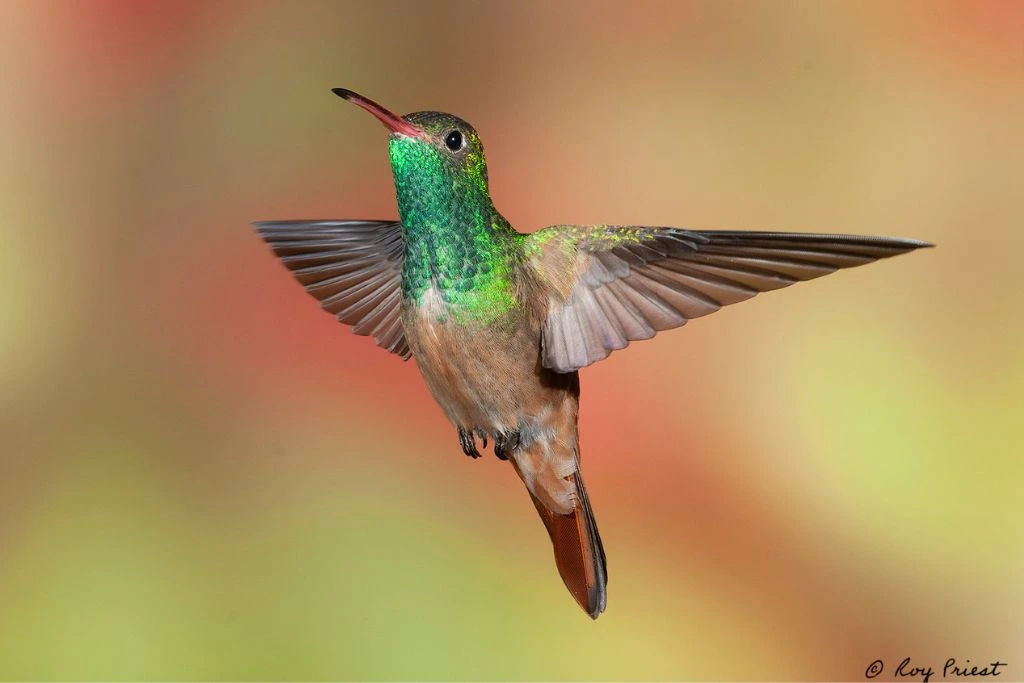
- Kingdom: Animalia
- Phylum: Chordata
- Class: Aves
- Order: Apodiformes
- Genus: Amazalia
- Species: Amazilia yucatanensis
- Length: 3.9-4.3 in (10-11 cm)
- Weight: 0.1-0.18 oz (2-5 g)
Southern Texas, the Yucatan Peninsula in Mexico, and Central America are breeding grounds for buff-bellied hummingbirds. The buff-bellied hummingbirds make brief winter migrations from the Gulf Coast to Louisiana and Florida. From April through August, nesting takes place in Texas in big, low-lying bushes or small trees. Each year, they can still have up to two broods and lay two white eggs.
The optimal environment for buff-bellied hummingbirds is semi-open areas or woodland borders, though they will also visit yards with flowers or nectar feeders. Their diets also include some small insects. You can draw in more Buff-bellied hummingbirds using nectar feeders and red tube flowers like Turk’s cap and red salvia.
2. Ruby-Throated Hummingbird
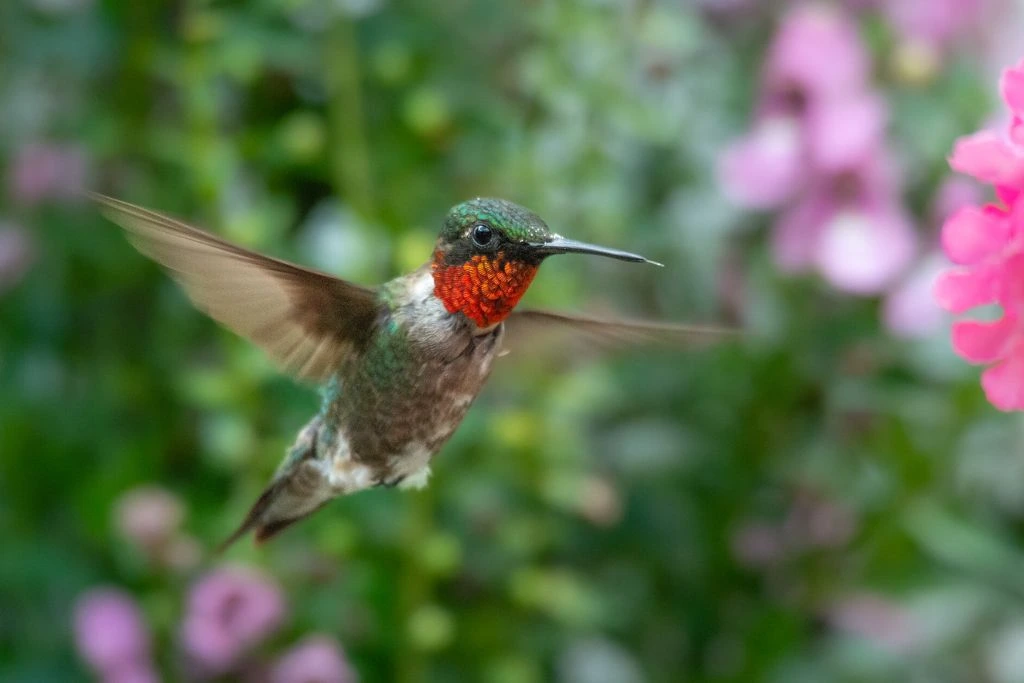
- Kingdom: Animalia
- Phylum: Chordata
- Class: Aves
- Order: Apodiformes
- Genus: Archilochus
- Species: Archilochus colubris
- Length: 2.8-3.5 in (7-9 cm)
- Weight: 0.1-0.2 oz (2-6 g)
- Wingspan: 3.1-4.3 in (8-11 cm)
Texas residents can view ruby-throated hummingbirds as they are migrating. The male ruby-throated hummingbirds has an iridescent red throat, and both sexes have vivid green throats and back with gray-white undersides.
These little birds fly from one nectar supply to another, catching insects in the air or on spiders’ webs. They will occasionally rest on a small branch, but because of their short legs, they can only wander along a perch.
When defending flowers and feeders, male ruby-throated hummingbirds can become hostile. After mating, they do not stay around for very long. By early August, they may have moved away. Ruby-throated hummingbird texas females construct their nests on slender twigs out of nettle or dandelion down that are bound together by spider silk.
3. Black-Chinned Hummingbird
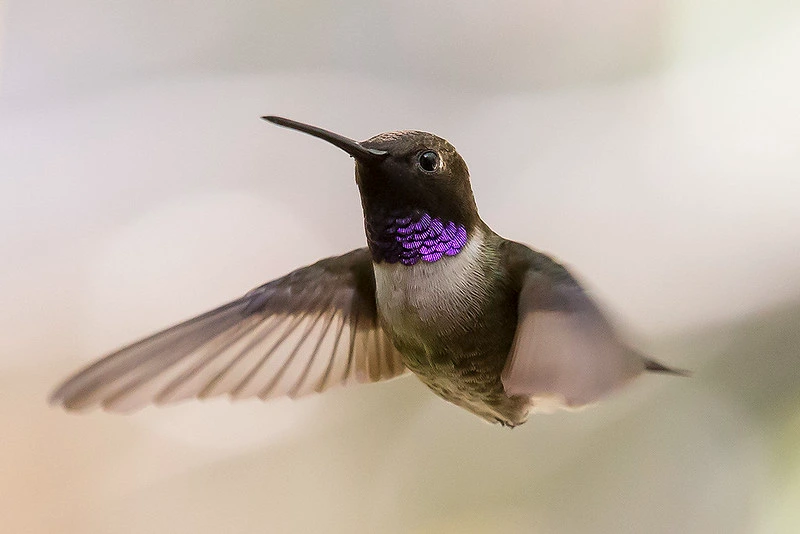
- Kingdom: Animalia
- Phylum: Chordata
- Class: Aves
- Order: Apodiformes
- Genus: Archilochus
- Species: Archilochus alexandri
- Length: 3.5 in (9 cm)
- Weight: 0.1-0.2 oz (2.3-4.9 g)
- Wingspan: 4.3 in (11 cm)
The black-chinned hummingbird is a frequent inhabitant of Southern Texas. In the winter, it can be seen along the Mexican and Southern California borders. It prefers a variety of landscapes, from highland forests to deserts. In cooler weather, this hummingbird can swallow up to three times its body mass in nectar. The black-chinned hummingbird may get by on an insect diet when nectar is scarce.
A brilliant purple band distinguishes the base of the black head and throat of the black-chinned hummingbird. The remains of its body are white, featuring green splodges. Females have a very different appearance from males, with a white chest, a green head, and no discernible black chin.
4. Rufous Hummingbird
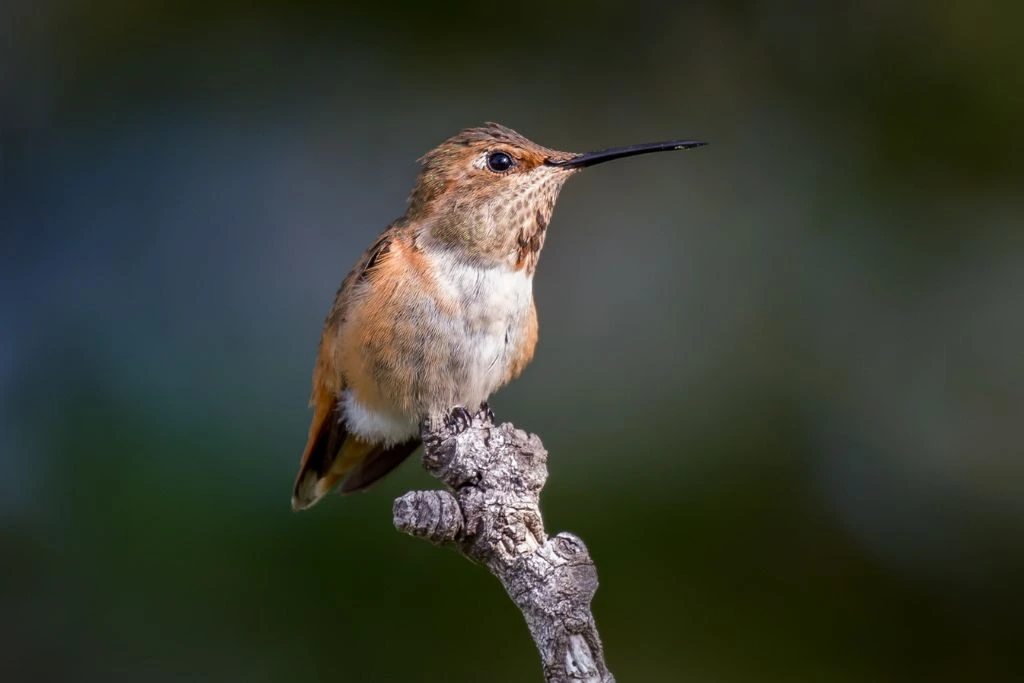
- Kingdom: Animalia
- Phylum: Chordata
- Class: Aves
- Order: Apodiformes
- Genus: Selasphorus
- Species: Selasphorus rufus
- Length: 2.8-3.5 in (7-9 cm)
- Weight: 0.1-0.2 oz (2-5 g)
- Wingspan: 4.3 in (11 cm)
Texas is home to Rufous hummingbirds, a migratory species. The Latin rubrum, “red,” is used to characterize the Rufous hummingbird’s reddish-brown hue. Male Rufous hummingbirds have rust-colored flanks, a tail, and an iridescent orange-red gorget. Although it can be confusing in the field, some females have stippling or spots of color close to the throat line, making them appear like juveniles.
The Rufous hummingbird texas is very possessive of its territory and hostile to other hummingbirds and creatures. They are known to be fierce and bold, hunting down other hummingbirds, large birds, and rodents from their preferred feeders. Mothers who approach their nest too closely have even been known to assault squirrels and chipmunks. Due to their exceptional memory, Rufous hummingbirds texas have been observed searching for old hummingbird feeders even years after they had been taken down.
5. Broad-Tailed Hummingbird
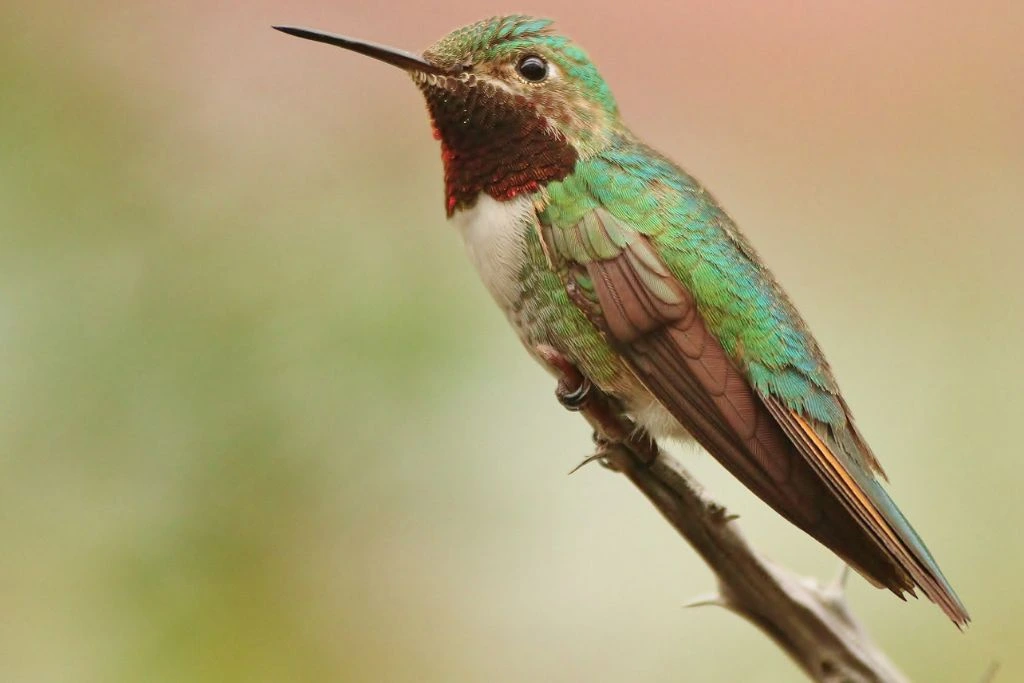
- Kingdom: Animalia
- Phylum: Chordata
- Class: Aves
- Order: Apodiformes
- Genus: Selasphorus
- Species: Selasphorus platycerus
- Length: 3.1-3.5 in (8-9 cm)
- Weight: 0.1-0.2 oz (2.8-4.5 g)
During migratory, broad-tailed hummingbirds can be spotted in the west and up toward the state’s north, where they breed in far Western Texas. They have an iridescent green back, brownish wings, and white chest and belly. They are found in higher elevations.
The broad-tailed hummingbird prefers mature forest woodland understory areas, like pine and oak groves. They opted to build their nests on tree branches, and they frequently (about 70% of the time) go back to their previous nesting area each year. For the greatest availability of food resources, they breed when native plants are at their peak blossoming. Their preferred flowering plants that provide nectar are Red Columbine, Indian Paintbrush, several sage species, currants, and Scarlet mint.
6. Anna’s Hummingbird
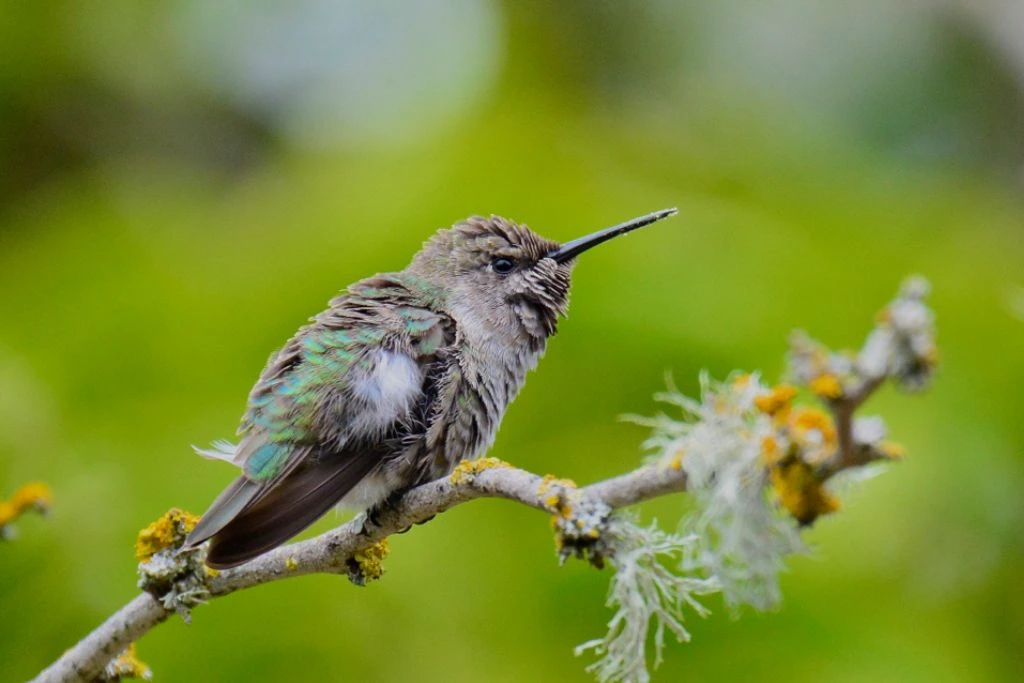
- Kingdom: Animalia
- Phylum: Chordata
- Class: Aves
- Order: Apodiformes
- Genus: Calypte
- Species: Calypte anna
- Length: 3.9 in (10 cm)
- Weight: 0.1-0.2 oz (3-6 g)
- Wingspan: 4.7 in (12 cm)
In Texas, Anna’s hummingbirds can be seen during the winter. They are little birds, primarily green and gray. The female’s throat is grayish with spots of red, whereas the male’s head and throat are a shimmering reddish-pink. The most frequent hummingbird all along the Pacific Coast is the unusually non-migratory Anna’s hummingbird.
The males perform a dramatic dive while courting, climbing as high as 130 feet in the air before plummeting back to the earth while making a loud noise with their tail feathers.
Although they can also be spotted in scrub and savannah, Anna’s hummingbirds prefer the back gardens and parks with their enormous, vibrant blooms and nectar feeders. The nests of Anna’s hummingbirds are located high in trees, between 6 and 20 feet up, and they frequently have two to three broods per year.
7. Lucifer Hummingbird
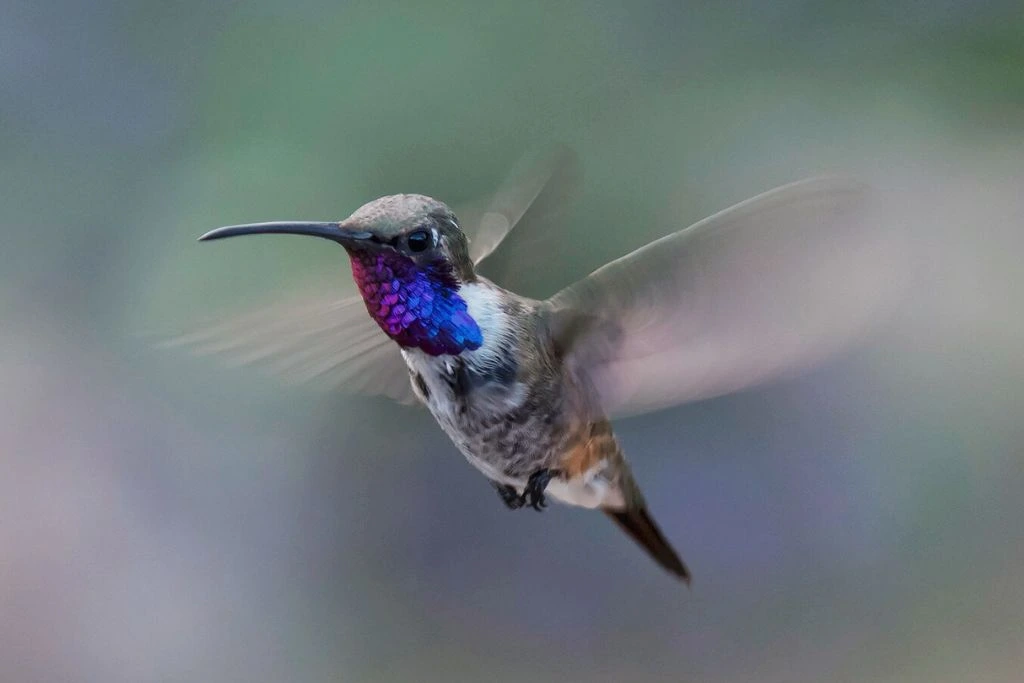
- Kingdom: Animalia
- Phylum: Chordata
- Class: Aves
- Order: Apodiformes
- Genus: Calothorax
- Species: Calothorax lucifer
- Length: 3.9 in (10cm)
- Weight: 0.1-0.1 oz (3-4 g)
Lucifer hummingbirds breed in the Davis Mountains and Big Bend National Park in Texas. The males have purple necks, forked tails, green backs, and curved bills.
These hummingbirds are typically found in arid canyons and desert settings, where they eat century, ocotillo, and flowering agave plants. They are a fairly sought-after species to detect because they are not frequently seen and because of their desert habitat.
During courtship displays, the males will suddenly descend about 100 feet ahead of the females. Between March and September, Lucifer hummingbirds reproduce in northern Mexico and a few isolated locations in Arizona, New Mexico, and Texas. For the winter, they move to Central Mexico. They will also have one or two broods per year, and their nests steadily increase over the years on cacti or succulents.
8. Calliope Hummingbird
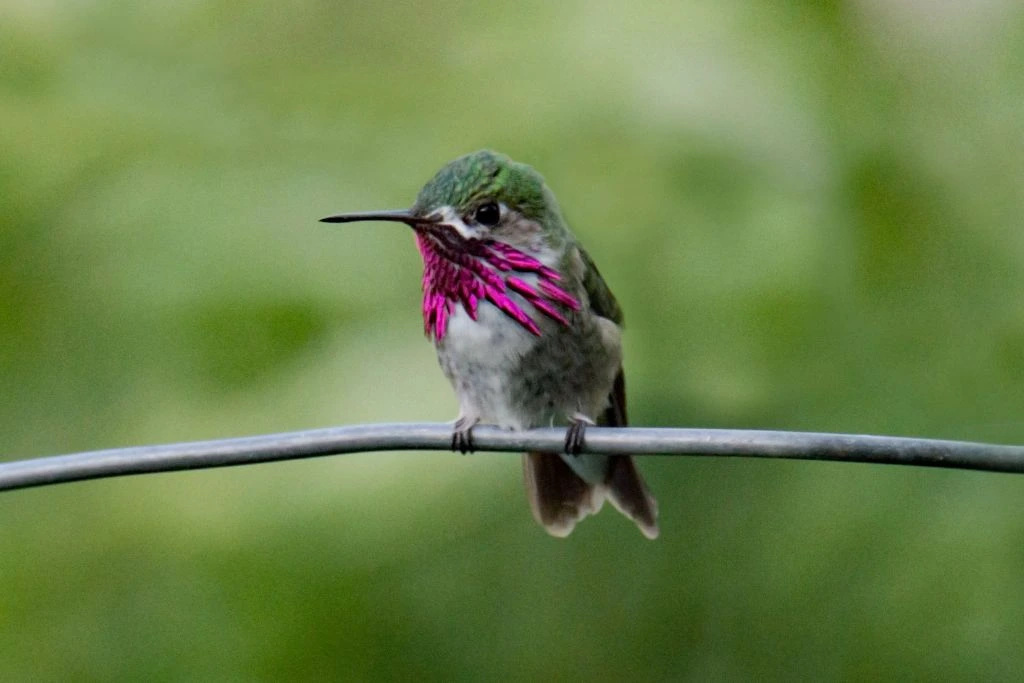
- Kingdom: Animalia
- Phylum: Chordata
- Class: Aves
- Order: Apodiformes
- Genus: Selasphorus
- Species: Selasphorus calliope
- Length: 3.1-3.5 in (8-9 cm)
- Weight: 0.1-0.1 oz (2.3-3.4 g)
- Wingspan: 4.1-4.3 in (10.5-11 cm)
Around Texas, Calliope hummingbirds are visible most of the year but not typically in June. Between mid-July and mid-September, when they migrate in the fall, they are more frequently spotted. The Calliope hummingbird, the tiniest bird in America with a size comparable to a ping pong ball, travels over 5000 miles annually from Mexico to Canada and back. Additionally, they fight bravely to defend their turf and even pursue red-tailed hawks.
Spring migration to the Rocky Mountains occurs along the Pacific Coast to breeding grounds in California, Colorado, and the northwestern states and Canada. They migrate relatively early, from the middle of April to the beginning of May. Typically found on evergreen trees, nests may be reused or built over an older nest. The Rocky Mountains are used during the fall migration to the wintering sites in Southwest Mexico.
9. Allen’s Hummingbird
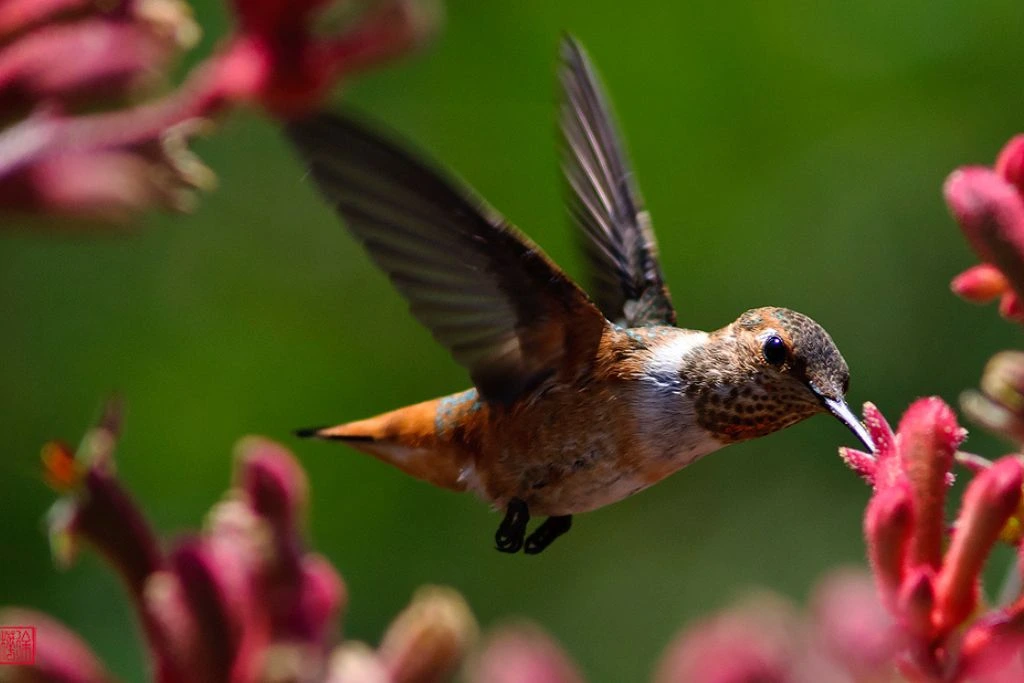
- Kingdom: Animalia
- Phylum: Chordata
- Class: Aves
- Order: Apodiformes
- Genus: Selasphorus
- Species: Selasphorus sasin
- Length: 3.5 in (9 cm)
- Weight: 0.1-0.1 oz (2-4 g)
- Wingspan: 4.3 in (11 cm)
Allen’s hummingbirds are less numerous in Texas but more frequent all along the California coast and across Southern Oregon. The male and female do not remain in the same environment during the breeding season. The female will withdraw into a thicket or forested location to build a nest, while the male hovers in open places on tree limbs. Allen’s hummingbirds have speckled green wings, a pale yellow body, and a brilliant orange throat.
Allen’s hummingbirds, both sexes, are solitary creatures. Outside of reproducing, they do not interact with one another. Allen’s hummingbirds are fiercely territorial and hostile toward other hummingbirds and bigger predatory birds, like hawks, much like a Rufous hummingbird. Their nesting season coincides exactly with the time of year when there is the highest rainfall in the area, which helps to ensure that their young will have an abundance of nectar-producing flowers.
10. Blue-Throated Mountain-Gem
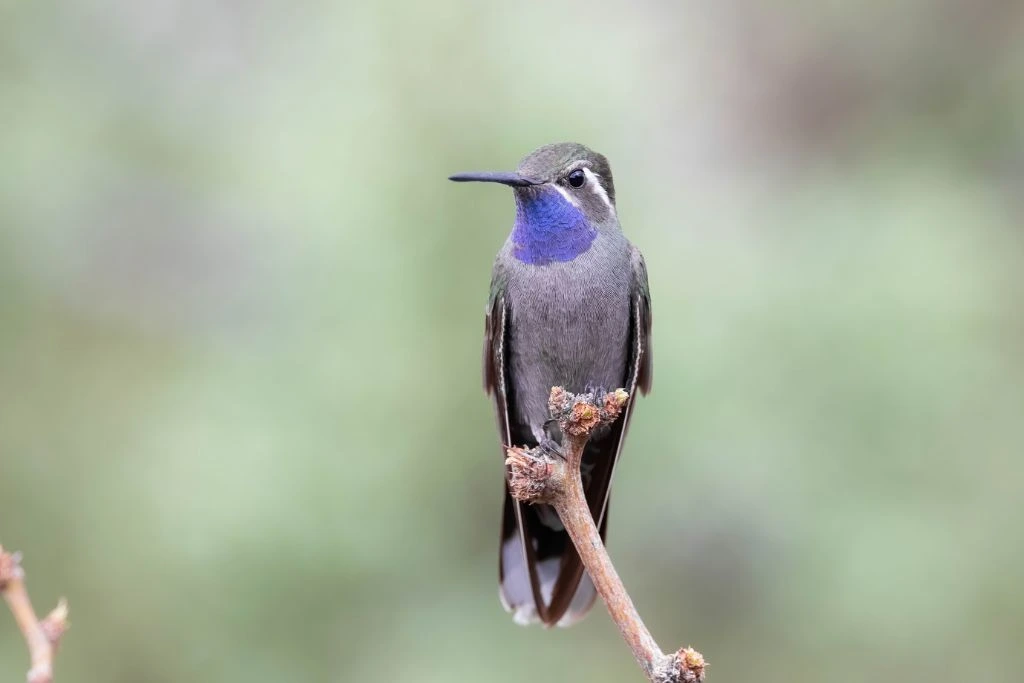
- Kingdom: Animalia
- Phylum: Chordata
- Class: Aves
- Order: Apodiformes
- Genus: Lampornis
- Species: Lampornis clemenciae
- Length: 4.3-4.7 in (11-12 cm)
- Weight: 0.3-0.3 oz (8.1-8.6 g)
Although uncommon, breeding blue-throated mountain-gems are common in Texas’s Chisos Mountains in the spring and summer. The largest hummingbird to nest in the United States is the blue-throated mountain-gem, and as its name suggests, the males have intense blue throats. The black tail feathers of males and females have white tips, both bronzy-green, on the back and grayish below.
Primarily found in Mexico, a few blue-throated mountain-gems occasionally travel briefly north into Southeast Arizona and Southwestern Texas. The best places to see blue-throated mountain-gem beauties are in backyards with feeders or mountain forests along streams with abundant flowers. They eat more during the morning and late in the day to avoid the midday heat. Nests of Blue-throated Mountain gems can be 2 inches wide and 3 to 10 inches high, which is larger than most to fit their larger size.
11. Broad-Billed Hummingbird
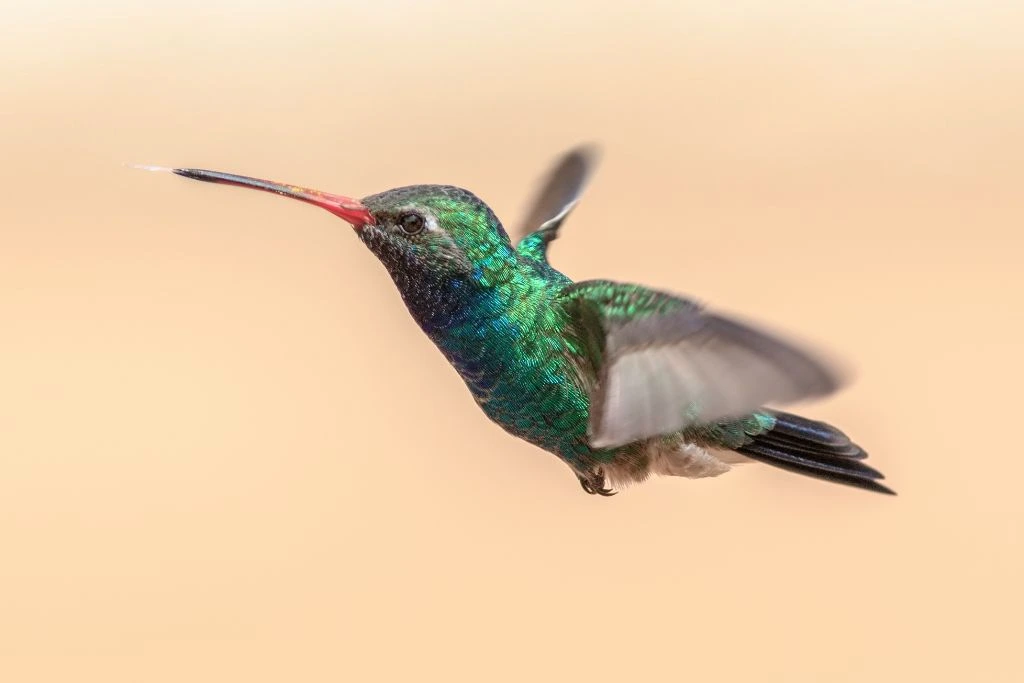
- Kingdom: Animalia
- Phylum: Chordata
- Class: Aves
- Order: Apodiformes
- Genus: Cynanthus
- Species: Cynanthus latirostris
- Length: 3.1 – 3.9 in (8-10 cm)
- Weight: 0.1-0.1 oz (3-4 g)
Mexican species of broad-billed hummingbirds are rare visitors to Texas. Near the Southern Mexican border, they make frequent trips to the US, but most of their population lives all year in Mexico and Central America. Even among hummingbirds, broad-billed hummingbirds have striking colors.
Another uncommon hummingbird that likes the mountains of Arizona and is rare in Texas. Surprisingly, in contrast to other hummingbird population figures, the broad-billed hummingbird has recently displayed a real rise in the overall population. The oldest male broad-billed hummingbird observed in the state during banding operations was almost nine years old.
12. Green-Breasted Mango
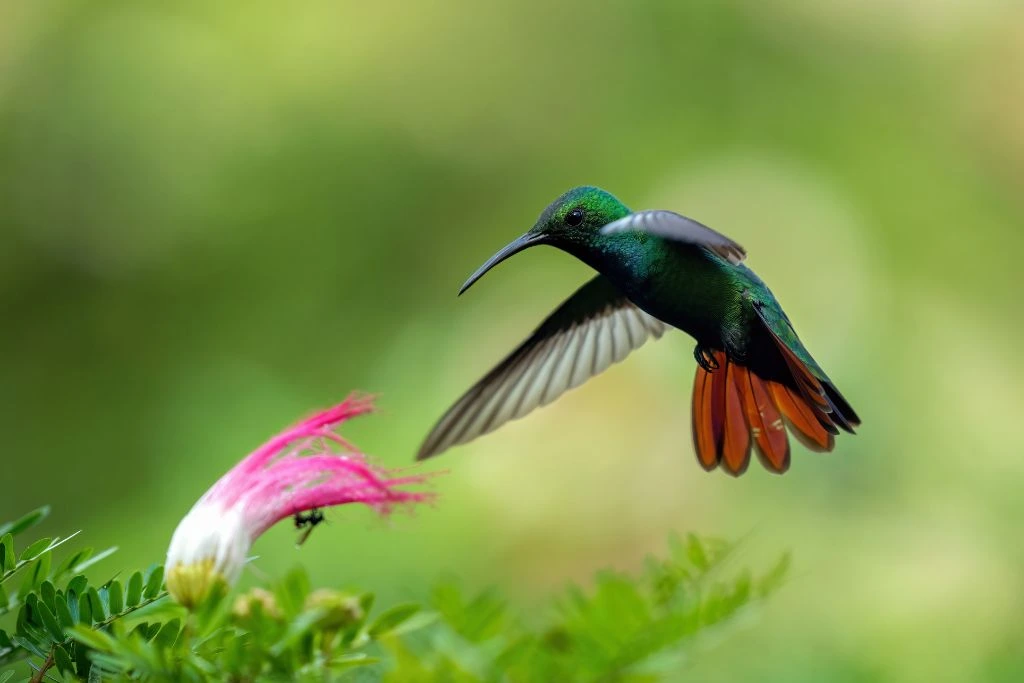
- Kingdom: Animalia
- Phylum: Chordata
- Class: Aves
- Order: Apodiformes
- Genus: Anthracothorax
- Species: Anthracothorax prevostii
- Length: 4.3 – 4.7 in ( 11 – 12 cm)
- Weight: 0.24-0.25 oz (6.8 – 7.2 g)
Although the green-breasted mango is uncommon in Texas, several have been seen on the state’s southeast border with Mexico. Male green-breasted mangoes have a brown or black throat, edged in blue on the chest, and their backs are glossy and bright green. Females have a black stripe running down the center of their white undersides, along with a few metallic bluish-green feathers. Their habitat comprises tropical deciduous forests, meadows, and a few open or moderately forested regions.
The French scientist, Florent Prevost, is honored with the green-breasted mango’s scientific name.
Native to Mexico, this green hummingbird texas can be found from Panama down to Central America’s tropical deciduous forests. There have only been three additional confirmed occurrences of green-breasted mango hummingbirds in the United States outside of Texas.
13. Violet-Crowned Hummingbird
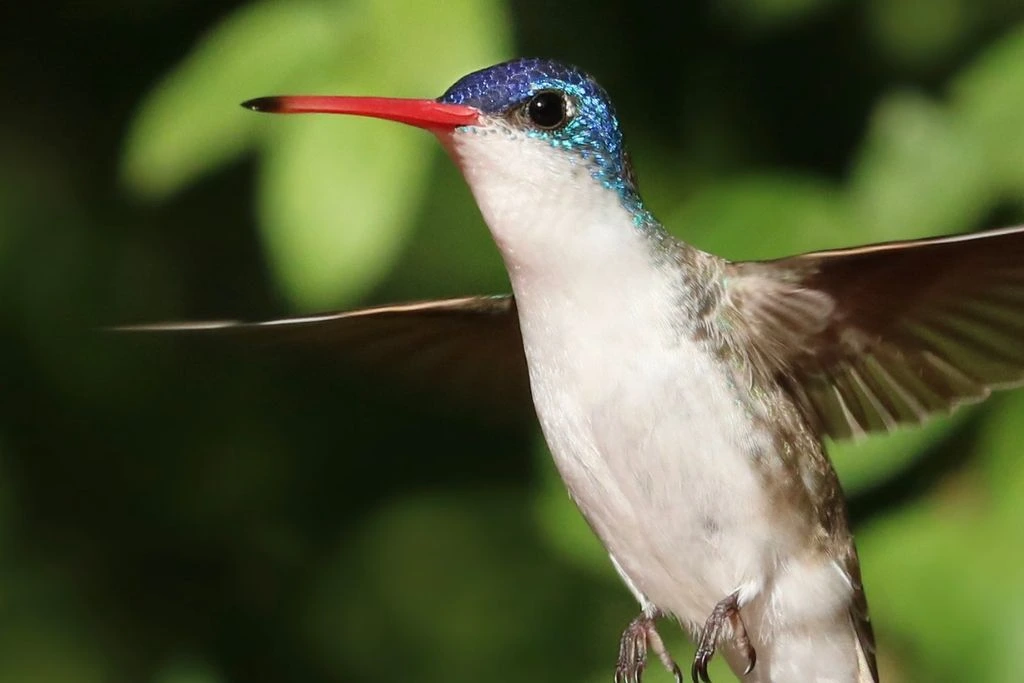
- Kingdom: Animalia
- Phylum: Chordata
- Class: Aves
- Order: Apodiformes
- Genus: Ramosomyia
- Species: Ramosomyia voliceps
- Length: 4 in (10 cm)
- Weight: 0.18 oz (5 g)
Although uncommon, violet-crowned hummingbirds are occasionally spotted in Texas near El Paso. As their name would imply, they are medium-sized and feature a violet cap. On the back, they have a deep olive-green color, and underneath, they are white. Their red beaks have black tips. Compared to males, females are less colorful.
From the mountains in Southeast Arizona and Southwestern New Mexico, violet-crowned hummingbirds can be found down to Southwest Mexico. They come into the country in February or March and, between April and September, they build their nests in Arizona and New Mexico. Most of them migrate south for the winter, but others might spend it at backyard feeders. The habitat consists of semiarid scrub and tropical deciduous forests, and nests are frequently found in sycamore or oak trees.
14. Magnificent Hummingbird

- Kingdom: Animalia
- Phylum: Chordata
- Class: Aves
- Order: Apodiformes
- Genus: Eugenes
- Species: Eugenes fulgens
- Length: 4.3–5.5 in (11–14 cm)
- Weight: 0.2–0.3 oz (7–8 g)
- Wingspan: 7.1 in (18 cm)
The magnificent hummingbird, formerly known as Rivoli’s hummingbird, is infrequently seen in Western Texas but is more frequent in Arizona and New Mexico. They prefer nesting in mountainous areas from Mexico through Costa Rica and Panama. The magnificent hummingbird consumes nectar and small bugs and insects caught in midair or plucked from spider webs. The blue-throated hummingbird is the largest hummingbird, with the magnificent hummingbird coming in second.
The male magnificent hummingbird has a neck patch that is a vivid blue-green color with a purple crown. With a splash of green on the wings, the rest of the body is bronze. The female has a gray underside and similar bronze-green plumage. Behind the eyes, both sexes have a recognizable white stripe.
Frequently Asked Questions
When do hummingbirds arrive in Texas?
They arrive seasonally. Based on egg dates between April 14 and June 22, most ruby-throated hummingbirds Texas arrive between mid-March and mid-May. They reproduce from early April to early September, and their young are fed as late as September 1st. These birds fly off to their wintering locations from late July to mid-November.
How common are hummingbirds in Texas?
Central and Western Texas is home to many black-chinned hummingbirds. They need a range in Texas for the eastern and northernmost portions of the state. Every year, they go north from Mexico and Central America to breed in the Eastern United States, from Texas to Idaho, and in every state west of that boundary.
What entices hummingbirds in Texas?
The greatest nectar is typically produced by tubular, brightly colored flowers because they are particularly alluring to hummingbirds. These include several annuals, such as cleome, impatiens, and petunias, as well as perennials like bee balms, dendrobiums, daylilies, and lupines, as well as biennials like foxgloves and hollyhocks.
Do hummingbirds live in Dallas, Texas?
Yes. Black-chinned and Rufous hummingbirds are widespread just to the west in cities like Dallas and Austin.
Are hummingbirds in Texas migratory?
Yes. Texas hosts hummingbirds all year long because it is a southern state. Though most migrate even farther south during the winter. Numerous hummingbirds traveling south to Mexico and Central America’s milder temperatures frequently stop in Texas.
What do hummingbirds eat in Texas?
They frequently consume insects they catch in the air and those they find in the nectar. Hummingbirds are believed to pursue sapsuckers during winter to consume the tree sap they take from their drilling holes.
What Texas town do the hummingbirds visit?
Rockport, Texas, a haven for birdwatchers, is situated directly along the route of this small bird species’ autumnal migration. Hummingbirds stop in Rockport every autumn to prepare for their trek’s hardest leg.
What states do not have hummingbirds?
Only Hawaii is completely devoid of the hummingbird species.
What’s the deal with the hummingbirds not eating?
There are now fewer natural food supplies or nesting locations, which has led the birds to move elsewhere. Despite their small size, pet cats that roam freely can harm or even kill hummingbirds. According to some research, a healthy wildflower harvest will result in fewer hummingbird visits to feeders.
What is the Hummingbird Moth Texas?
The hummingbird moth texas is most likely Hemaris thysbe, also known as the Hummingbird Clearwing moth or common clearwing (wingspan 38-50 mm), which looks so much like a hummingbird when feeding that many people don’t realize it’s a moth hovering over the flowers.


